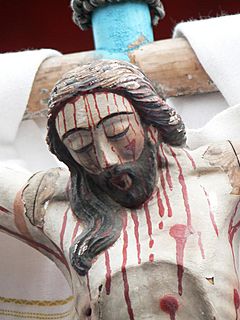Chilote School of Religious Imagery

Procession Christ, Church of Caguach (18th century).
Articulated Sculpture from chilota School of imagery. |
|
| Localization | Chiloé Archipelago, |
|---|---|
| Artistic manifestation | Colonial Hispano-American Art |
| Style | Religious art |
| Historic period | 16th century - 19th century |
| Number of exponents | At least 456 pieces |
| Material | Polychrome wood as a typical element. |
The Chilote School of Religious Imagery is a special kind of art that grew in the Chiloé Archipelago in Chile. It started in the 1600s and became very popular by the late 1800s. This art style was created because of the work of Jesuit missionaries who came to teach about Christianity.
This art is called a "school" because it has a unique style. It changed the usual look of religious statues from Europe and other parts of America. The art from Chiloé mixes ideas from European, Latin American, and Indigenous cultures. This mix makes the sculptures very special and different from art found in places like Spain or other parts of South America. You can see big differences in how they were made, the materials used, and their overall style.
Contents
What is the Chilote School of Imagery?
The Chilote School of Religious Imagery is a unique art movement. It focuses on creating religious statues, often made from wood. These statues are usually painted with many colors, a style called polychrome. The artists in Chiloé developed their own way of making these figures. They used local materials and combined different artistic traditions.
A Blend of Cultures
What makes this art school stand out is its mix of cultures. It combines European art styles with local Indigenous traditions. It also includes influences from other parts of Latin America. This blending of cultures is called syncretism and miscegenation. It means that new ideas and styles were created by mixing different groups of people and their beliefs. The result was a fresh and original art form.
How it Started
The Chilote School began in the 17th century. Jesuit missionaries played a big role in its development. They traveled around the islands of Chiloé, teaching Christianity. As part of their mission, they encouraged the creation of religious images. Local artists learned European techniques but also added their own cultural touches. This led to the unique style we see today. The art became very important to the people of Chiloé.
Unique Features of the Sculptures
The sculptures from the Chilote School have distinct features. They often show a different way of presenting religious figures. For example, some statues might have movable parts, like arms or legs. This allowed them to be posed during religious processions. The artists used wood, which was common in the region. They painted the statues with bright colors, making them very lively. Each piece tells a story of the blend of cultures in Chiloé.
See also
 In Spanish: Escuela chilota de imaginería para niños
In Spanish: Escuela chilota de imaginería para niños

